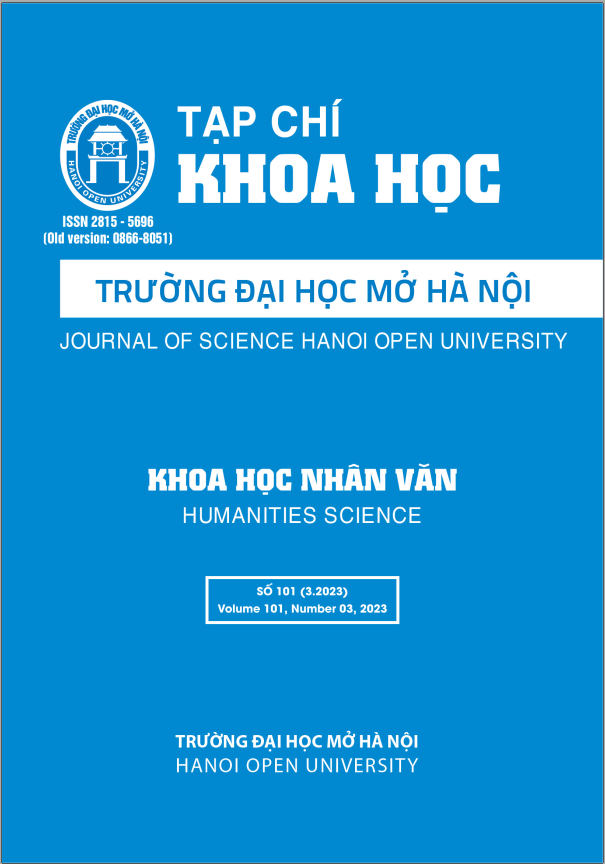USING VIDEO-BASED LEARNING TO IMPROVE LISTENING SKILLS FOR FIRST-YEAR ENGLISH MAJORS AT HANOI OPEN UNIVERSITY
Từ khóa:
Video-based learning, Blended learning, , favorable learning environment, learner autonomyTóm tắt
The study aims at investigating the first-year English majored students’ perceptions of using video based learning and their practices in learning English listening skills at Faculty of English, Hanoi Open University. A quantitative research has been employed in this study. The structured questionnaire for collecting data was administered to 116 participants from class K29X,Y,Z,Y. The results of the survey reveal that almost students are aware of the roles of video based learning. In addition, the results also indicate that the students really want to improve their autonomous learning by using video based learning. They also agree that blended learning, a way of learning that combines traditional classroom lessons with lessons that use computer technology should be applied. Therefore, teachers should create favorable learning environment and strategies to facilitate learner autonomy in learning English listening skills and motivate them to use listening sub-skills by using video based learning effectively.
Tài liệu tham khảo
[1]. Ahmadi, S. M. (2016). The Importance of Listening Comprehension in Language Learning. International Journal of Research in English Education, 1(1), 7–10. www. ijreeonline.com.
[2]. Anthony, B., Kamaludin, A., Romli, A. et al. Exploring the role of blended learning for teaching and learning effectiveness in institutions of higher learning: An empirical investigation. Educ Inf Technol 24, 3433–3466 (2019). https://doi.org/10.1007/s10639-019-09941-z
[3]. Bentley, S., & Bacon, S. (1996). The all new, state-of-the-art ILA definition of listening: Now that we have it, what do we do with it? Listening Post, 56, 1-5.
[4]. Buket AKKOYUNLU, Meryem YILMAZ SOYLU. A Study on Students’ Views On Blended Learning Environment Turkish Online Journal of Distance Education- TOJDE July 2006 ISSN 1302-6488 Volume: 7 Number: 3 Article: 3
[5]. Caruso, Marinella; Gadd Colombi, Anna; and Tebbit, Simon, Teaching how to Listen. Blended Learning for the Development and Assessment of Listening Skills in a Second Language, Journal of University Teaching & Learning Practice, 14(1), 2017.
[6]. David L. Vannette (2014) Questionnaire Design: Theory and Best Practices. Stanford University- Institute for Research in the Social Sciences Computational Social Science. Workshop September 15th, 2014
[7]. Gary Buck, (2001). What Practitioners says about Listening: Research Implications for the Classroom. Foreign Language Annals, 17: p31.
[8]. Nagham Mamdouh Ibrahim, Utilizing a Blended Learning Strategy to Enhance EFLStudents’ Listening Comprehension Skills at the Faculty of Specific Education Palarch’s Journal Of Archaeology Of Egypt/ Egyptology 17(7), ISSN 1567-214x
[9]. Immanuel Vinikas, (2022) Video-Based Learning Strategy, Updated June 29 2022 https://corp.kaltura.com/blog/video-based- learning
[10]. Priyanwada Jayarathne. (2021) Blended learning and listening skills, 16 Feb 2021 https://www.tesol.org/connect/tesol-resource-center/search-details/teaching- tips/2021/02/16/blended-learning-and- listening-skills
[11]. Kramer, M., Förtsch, C., Stürmer, J., Förtsch, S., Seidel, T., & Neuhaus, B.J. (2020). Measuring biology teachers’ professional vision: development and validation of a video-based assessment tool. Cogent Education. https://doi.org/10.1080/ 2331186X.2020.1823155
[12]. Lemke J. (2007), Video epistemology in- and- outside the box. Traversing attentional spaces, in Goldman R. et al, Video research in the learning sciences, Lawrence Erlbauum Association.
[13]. Nickl, M., Huber, S.A., Sommerhoff, D. et al. Video-based simulations in teacher education: the role of learner characteristics as capacities for positive learning experiences and high performance. Int J Educ Technol High Educ 19, 45 (2022). https://doi.org/10.1186/s41239-022-00351-9
[14]. Osguthorpe, R., & Graham, C. (2003). Blended learning environments: Definitions and directions. The Quarterly Review of Distance Education, 4 (3), 227-233.
[15]. Putri, M., & Sinaga, J. B. (2020). The Effect of Watching English Movie to Improve Students’ Listening Skill. Anglo Saxon: Jurnal Ilmiah Program Studi Pendidikan Bahasa Inggris, 11(1), 110–117. https:// doi.org/10.33373/as.v11i1.2449.
[16]. Saris, W.E. and Gallhofer, I. (2007), Design, Evaluation and Analysis of Questionnaires for Survey Research, Wiley Interscience, Hoboken, NJ.
[17].Thanajaro, M. (2000). Using authentic materials to develop listening comprehension in the English as a Second Language Classroom. PhD. dissertation. Virginia Polytechnic Institute and State University.
[18]. Nguyễn Thị Kim Chi. Strategies to improve learner autonomy in English listening skills for first-year English majors at Hanoi Open University, Journal of science Hanoi Open University Vol 87 (02.2022) 38-46
Websites:
[19]. https://www.easygenerator.com/en/blog/ e-learning/what-is-video-based-learning/
[20]. https://www.teachthought.com/learning/ the-definition-of-blended-learning/
[21]. https://en.wikipedia.org/wiki/Blended_ learning
[22]. https://dictionary.cambridge.org/diction ary/english/blended-learning
[23]. https://www.readinghorizons.com/liter acy-articles/blended-reading-approach/what- is-the-role-of-a-teacher
[24]. https://elearningindustry.com/5-roles- educator-blended-classroom
[25]. https://youglish.com/
[26]. https://learningcarton.com/the-6-types- of-video-for-learning/
